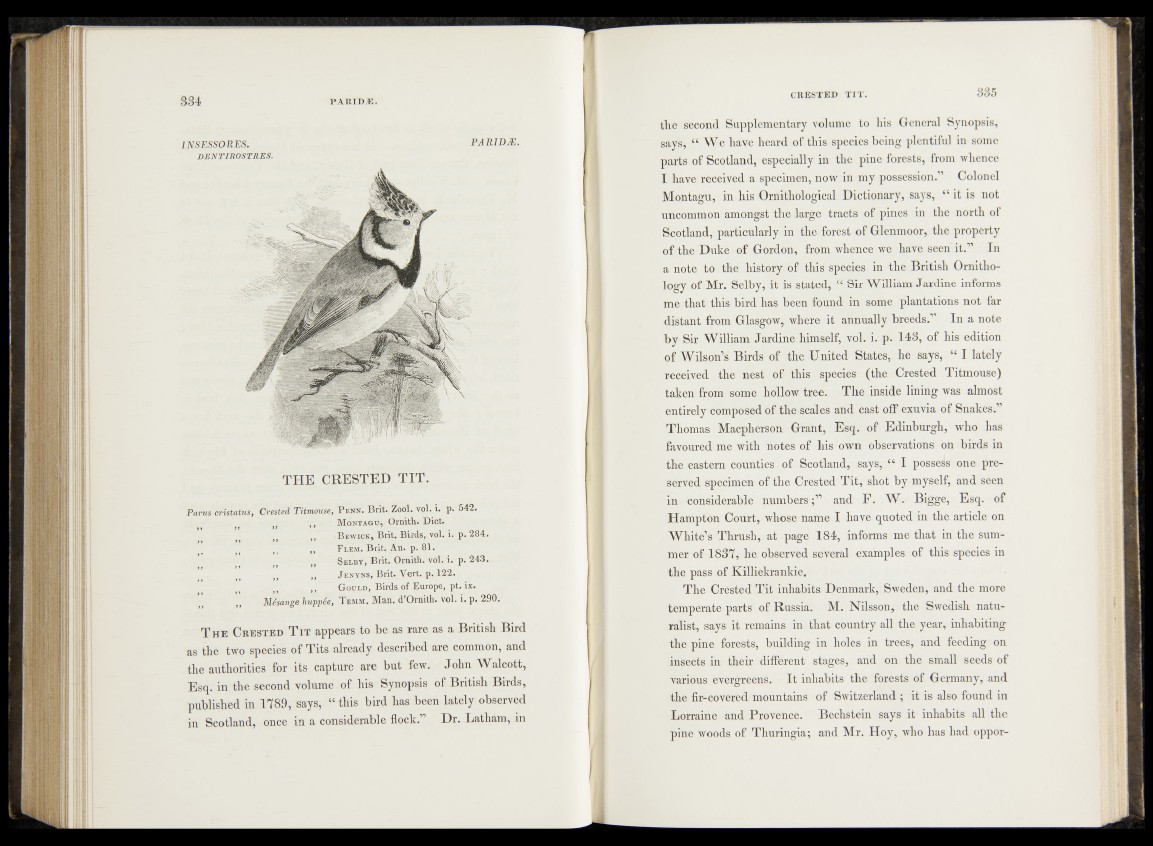
1NSESS0RES.
EENTIROSTRE S .
PARIDÆ.
TH E CRESTED T IT .
Parus cristatus, Crested Titmouse, P enn. Brit. Zool. vol. i. p. 542.
tt t , M ontagu, Ornith. Diet.
,, B ewick, Brit. Birds, vol. i. p. 284.
M tl F lem. Brit. An. p. 81.
,, ,, „ S elby, Brit. Ornith. vol. i. p. 243.
„ J enyns, Brit. Yert. p. 122.
,, G ould, Birds of Europe, pt. ix.
,, Mésange huppée, T emm. Man. d’Ornith. vol. i. p. 290.
T h e C r e s t e d T i t appears to be as rare as a British Bird
as the two species of Tits already described are common, and
the authorities for its capture are but few. John Walcott,
Esq. in the second volume of his Synopsis of British Birds,
published in 1789, says, “ this bird has been lately observed
in Scotland, once in a considerable flock.'” Dr. Latham, in
the second Supplementary volume to his General Synopsis,
says, “ We have heard of this species being plentiful in some
parts of Scotland, especially in the pine forests, from whence
I have received a specimen, now in my possession.” Colonel
Montagu, in his Ornithological Dictionary, says, “ it is not
uncommon amongst the large tracts of pines in the north of
Scotland, particularly in the forest of Glenmoor, the property
of the Duke of Gordon, from whence we have seen it.” In
a note to the history of this species in the British Ornithology
of Mr. Selby, it is stated, 1 Sir William Jardine informs
me that this bird has been found in some plantations not far
distant from Glasgow, where it annually breeds.” In a note
by Sir William Jardine himself, vol. i. p. 143, of his edition
of Wilson’s Birds of the United States, he says, ff I lately
received the nest of this species (the Crested Titmouse)
taken from some hollow tree. The inside lining was almost
entirely composed of the scales and cast off exuvia of Snakes.”
Thomas Macpherson Grant, Esq. of Edinburgh, who has
favoured me with notes of his own observations on birds in
the eastern counties of Scotland, says, “ I possess one preserved
specimen of the Crested Tit, shot by myself, and seen
in considerable n u m b e r s a n d F . W^. Bigge, Esq. of
Hampton Court, whose name I have quoted in the article on
White’s Thrush, at page 184, informs me that in the summer
of 1837, he observed several examples of this species in
the pass of Killiekrankie.
The Crested Tit inhabits Denmark, Sweden, and the more
temperate parts of Russia. M. Nilsson, the Swedish naturalist,
says it remains in that country all the year, inhabiting
the pine forests, building in holes in trees, and feeding on
insects in their different stages, and on the small seeds of
various evergreens. It inhabits the forests of Germany, and
the fir-covered mountains of Switzerland ; it is also found in
Lorraine and Provence. Bechstein says it inhabits all the
pine woods of Thuringia; and Mr. Hoy, who has had oppor